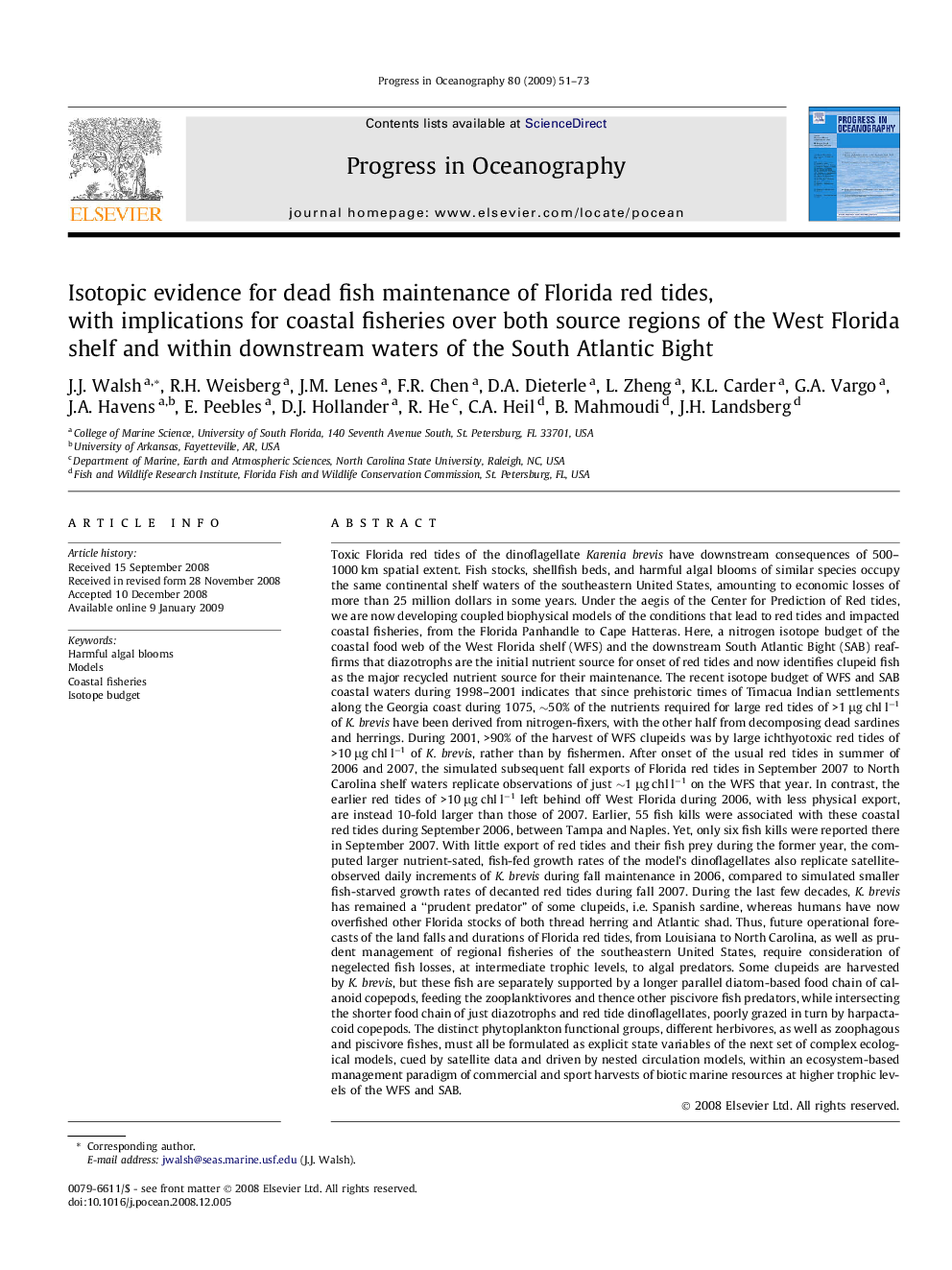| کد مقاله | کد نشریه | سال انتشار | مقاله انگلیسی | نسخه تمام متن |
|---|---|---|---|---|
| 4553662 | 1627968 | 2009 | 23 صفحه PDF | دانلود رایگان |

Toxic Florida red tides of the dinoflagellate Kareniabrevis have downstream consequences of 500–1000 km spatial extent. Fish stocks, shellfish beds, and harmful algal blooms of similar species occupy the same continental shelf waters of the southeastern United States, amounting to economic losses of more than 25 million dollars in some years. Under the aegis of the Center for Prediction of Red tides, we are now developing coupled biophysical models of the conditions that lead to red tides and impacted coastal fisheries, from the Florida Panhandle to Cape Hatteras. Here, a nitrogen isotope budget of the coastal food web of the West Florida shelf (WFS) and the downstream South Atlantic Bight (SAB) reaffirms that diazotrophs are the initial nutrient source for onset of red tides and now identifies clupeid fish as the major recycled nutrient source for their maintenance. The recent isotope budget of WFS and SAB coastal waters during 1998–2001 indicates that since prehistoric times of Timacua Indian settlements along the Georgia coast during 1075, ∼50% of the nutrients required for large red tides of >1 μg chl l−1 of K.brevis have been derived from nitrogen-fixers, with the other half from decomposing dead sardines and herrings. During 2001, >90% of the harvest of WFS clupeids was by large ichthyotoxic red tides of >10 μg chl l−1 of K.brevis, rather than by fishermen. After onset of the usual red tides in summer of 2006 and 2007, the simulated subsequent fall exports of Florida red tides in September 2007 to North Carolina shelf waters replicate observations of just ∼1 μg chl l−1 on the WFS that year. In contrast, the earlier red tides of >10 μg chl l−1 left behind off West Florida during 2006, with less physical export, are instead 10-fold larger than those of 2007. Earlier, 55 fish kills were associated with these coastal red tides during September 2006, between Tampa and Naples. Yet, only six fish kills were reported there in September 2007. With little export of red tides and their fish prey during the former year, the computed larger nutrient-sated, fish-fed growth rates of the model’s dinoflagellates also replicate satellite-observed daily increments of K.brevis during fall maintenance in 2006, compared to simulated smaller fish-starved growth rates of decanted red tides during fall 2007. During the last few decades, K.brevis has remained a “prudent predator” of some clupeids, i.e. Spanish sardine, whereas humans have now overfished other Florida stocks of both thread herring and Atlantic shad. Thus, future operational forecasts of the land falls and durations of Florida red tides, from Louisiana to North Carolina, as well as prudent management of regional fisheries of the southeastern United States, require consideration of negelected fish losses, at intermediate trophic levels, to algal predators. Some clupeids are harvested by K.brevis, but these fish are separately supported by a longer parallel diatom-based food chain of calanoid copepods, feeding the zooplanktivores and thence other piscivore fish predators, while intersecting the shorter food chain of just diazotrophs and red tide dinoflagellates, poorly grazed in turn by harpactacoid copepods. The distinct phytoplankton functional groups, different herbivores, as well as zoophagous and piscivore fishes, must all be formulated as explicit state variables of the next set of complex ecological models, cued by satellite data and driven by nested circulation models, within an ecosystem-based management paradigm of commercial and sport harvests of biotic marine resources at higher trophic levels of the WFS and SAB.
Journal: Progress in Oceanography - Volume 80, Issues 1–2, January–February 2009, Pages 51–73